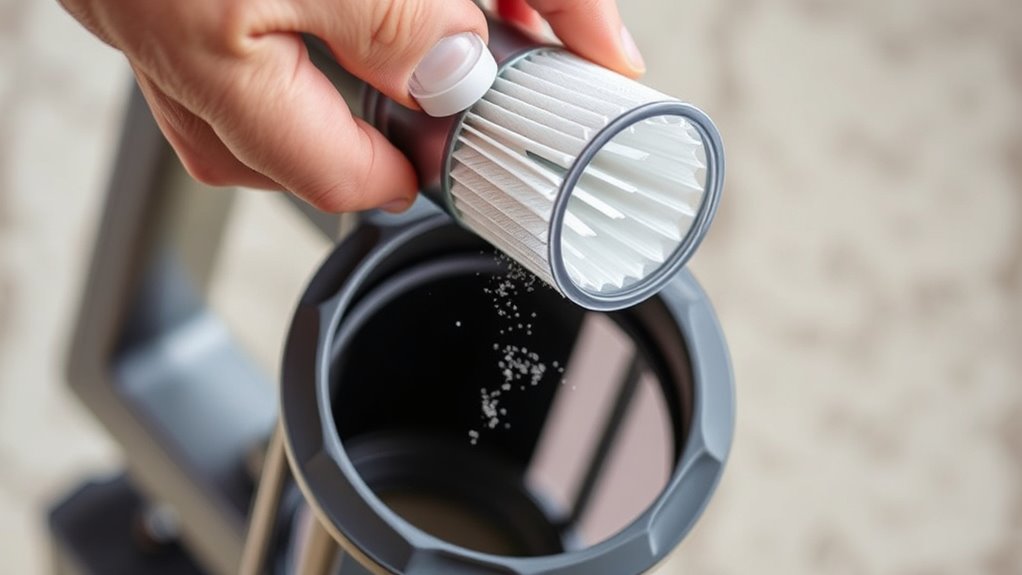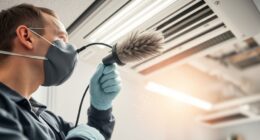To clean your vacuum and replace filters, start by unplugging the device, then remove the vacuum bag or bin and discard it properly. Wipe down or wash the bin if needed. Check and clear any blockages in hoses or brush rolls, and clean or replace the filters according to the manufacturer’s schedule. Winding the cord loosely and inspecting for damage also help keep it in good shape. Keep going to discover more tips for maintaining your vacuum effectively.
Key Takeaways
- Regularly empty or replace the vacuum bag before it overflows to maintain suction and prevent motor strain.
- Unplug the vacuum, then clean or replace filters according to the manufacturer’s instructions to ensure optimal airflow.
- Inspect and clear blockages in the hose and brush roll to prevent suction loss and mechanical issues.
- Wipe down or wash removable parts like filters and dust compartments, allowing them to dry completely before reassembly.
- Wind the cord loosely around designated hooks after use to prevent damage and keep it neat for future cleaning.

Keeping your vacuum clean is essential to maintaining its performance and extending its lifespan. Regularly checking and replacing the vacuum bag when it’s full ensures ideal suction and prevents debris from clogging the system. When it’s time for a vacuum bag replacement, don’t wait until it’s overflowing. A full bag can strain the motor and reduce cleaning efficiency. Open the vacuum compartment carefully, remove the old bag, and dispose of it in a sealed bag to prevent dust from escaping. Insert a new bag, making sure it’s properly sealed and fitted to avoid leaks. This simple step keeps your vacuum running smoothly and prevents unnecessary wear on its parts.
Regularly replacing your vacuum bag ensures optimal suction and prolongs your vacuum’s lifespan.
Another important aspect of maintenance is cord storage. Properly storing the power cord after each use not only prolongs its life but also keeps your space tidy and safe. Once you finish vacuuming, wind the cord loosely around designated hooks or compartments, avoiding tight coils that can damage the wire over time. Make sure the plug is unplugged from the socket before winding the cord to prevent electrical hazards. Keeping the cord neatly stored prevents tripping hazards and makes your vacuum easier to handle and store. It also protects the cord from abrasion, cuts, or other damage that could impair its function.
Beyond bag replacement and cord storage, regularly inspecting your vacuum for clogs or blockages in the hose and brush roll can prevent loss of suction and mechanical issues. Clear out any debris or tangled hair that might hinder performance. Cleaning or replacing filters is equally important because dirty filters restrict airflow, making the motor work harder and reducing cleaning power. Most vacuums have filter indicators or recommended replacement schedules—check your user manual to stay on top of it. Additionally, regular maintenance can help prevent costly repairs and ensure your vacuum continues to operate efficiently.
Maintaining your vacuum isn’t complicated, but consistency makes a big difference. Incorporate these habits into your routine: replace the vacuum bag when full, wind the cord properly after each use, and check filters and brush rolls periodically. These steps help your vacuum operate at peak performance, improve its longevity, and ensure your home stays clean with less effort. By paying attention to these details, you’re not just cleaning your floors—you’re also taking care of your investment. Regular maintenance doesn’t take much time but can save you money and hassle in the long run.
Frequently Asked Questions
How Often Should I Replace My Vacuum Filters?
You should replace your vacuum filters every 3 to 6 months, depending on the filter’s lifespan and your usage. Regularly check for signs of dirt buildup or reduced suction, which indicate it’s time for a replacement. Following the recommended replacement schedule helps maintain peak vacuum performance and air quality. Keep track of your filter’s condition, and don’t wait too long to change it for the best cleaning results.
Can I Wash All Vacuum Filters Safely?
You can’t wash all vacuum filters safely; check your filter type first. HEPA and foam filters often tolerate washing, which helps with air filter maintenance and vacuum odor control. Avoid washing paper filters, as they can disintegrate. Always follow your manufacturer’s instructions. Regularly cleaning washable filters improves air quality and reduces odors, but replacing non-washable filters when needed keeps your vacuum working efficiently and maintains good indoor air quality.
What Tools Are Best for Cleaning Vacuum Brushes?
Cleaning vacuum brushes is like giving your machine a spa day. Use a pair of scissors or a seam ripper to remove hair and debris tangled around the brush. For tool selection, a small brush or toothbrush works best to scrub away dirt and dust. These tools help with brush maintenance and make certain your vacuum performs efficiently, making it easier to keep your home spotless.
Are There Specific Cleaning Steps for Robot Vacuums?
Yes, robot vacuum maintenance involves specific cleaning steps. You should regularly remove and clean the brushes, clear debris from sensors, and clean or replace the filters. To clean robot filters, gently tap them to remove dust or wash them if they’re washable, following manufacturer instructions. This keeps your cleaning robot running efficiently and prolongs its lifespan, ensuring it continues to pick up dirt effectively with minimal issues.
How Do I Prevent My Vacuum From Clogging?
Think of your vacuum as a racecar—smooth operation depends on regular upkeep. To prevent it from clogging, focus on air filter maintenance and dust containment strategies. Regularly empty the dustbin and check filters for debris. Use a brush to clear blockages in hoses and nozzles. Keeping these parts clean guarantees your vacuum runs efficiently, avoiding clogs and prolonging its lifespan. Stay proactive, and your vacuum will stay in top form.
Conclusion
Now that you know how to clean your vacuum and replace its filters, you’re ready to keep it running smoothly. Think of your vacuum as a trusty steed—its power depends on proper care. Regular cleaning and filter changes are like giving it a fresh breath of life, ensuring it whips through dirt with ease. With these simple steps, you’ll keep your home spotless and your vacuum happy, ready for many more cleaning adventures ahead.









